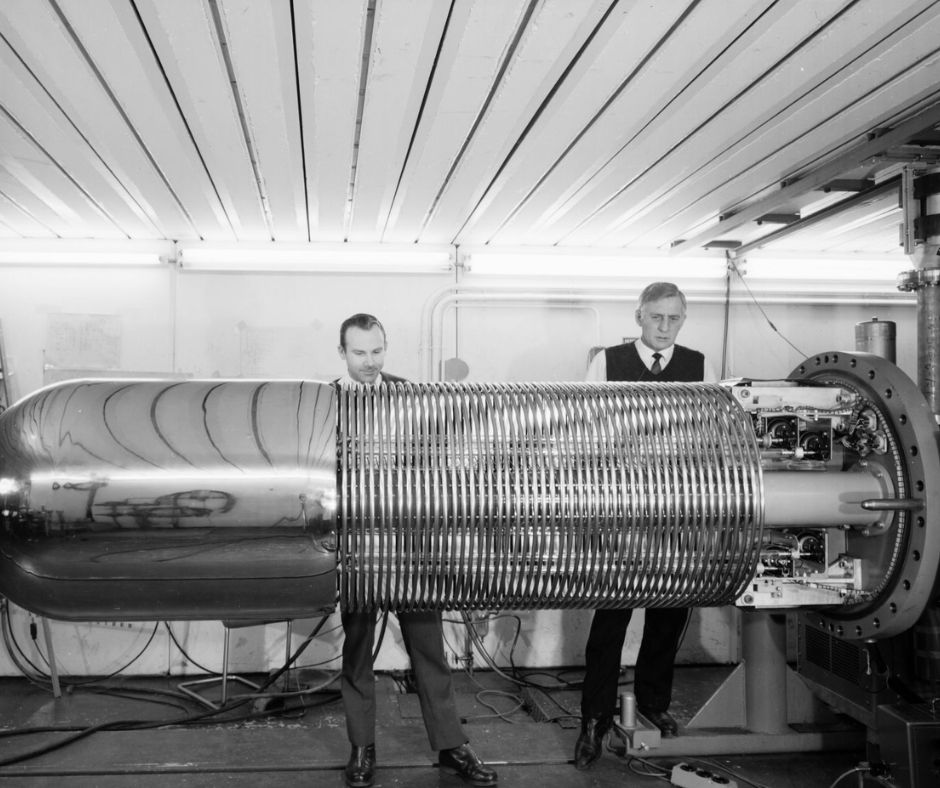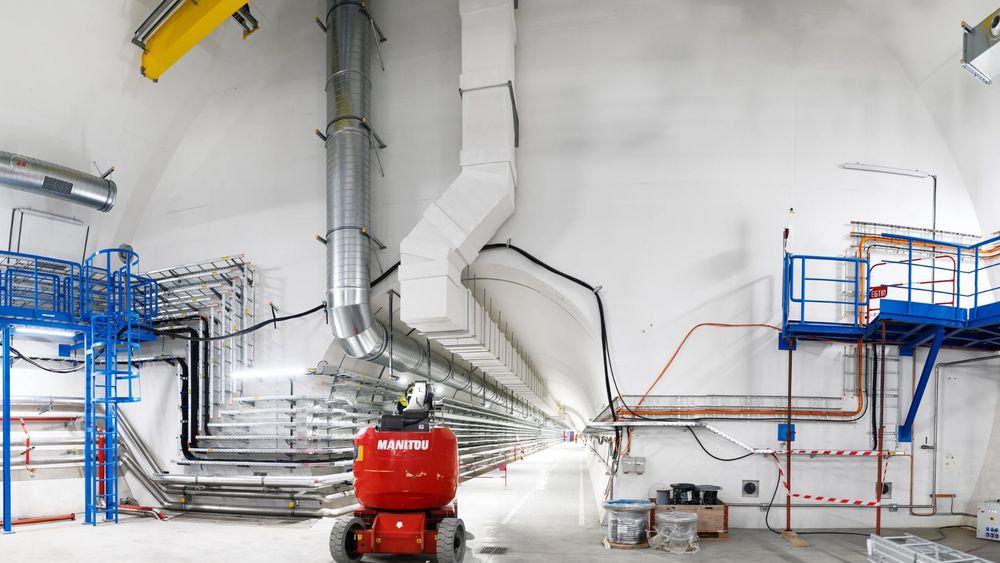Find out more: home.cern/news/news/ac...
01.12.2025 08:01 — 👍 13 🔁 3 💬 0 📌 0CERN
@cern.bsky.social
CERN is the European laboratory for particle physics, home to the Large Hadron Collider. linktr.ee/CERN_official
@cern.bsky.social
CERN is the European laboratory for particle physics, home to the Large Hadron Collider. linktr.ee/CERN_official
Find out more: home.cern/news/news/ac...
01.12.2025 08:01 — 👍 13 🔁 3 💬 0 📌 0The six new compressors are the first pieces of equipment to be installed above ground. They will soon be joined by cold boxes to form the two new refrigeration systems that will cool the HL-LHC installations, in addition to the eight current refrigerators that serve the LHC today.
01.12.2025 08:01 — 👍 15 🔁 2 💬 1 📌 0To achieve the expected ten-fold increase of luminosity, new, more powerful focusing magnets will be installed on either side of the @atlasexperiment.bsky.social and @cmsexperiment.bsky.social, requiring more cryogenic power.
01.12.2025 08:01 — 👍 10 🔁 0 💬 1 📌 0Here we see the delivery of warm helium compressors for the High-Luminosity Large Hadron Collider, the successor to CERN's Large Hadron Collider.
01.12.2025 08:01 — 👍 170 🔁 22 💬 12 📌 5
Superconductivity for addressing global challenges
A CERN event brings together researchers, industry leaders and decision makers to accelerate the use of superconducting technologies for societal applications
Find out more: home.cern/news/news/kn...




HIE-ISOLDE: 10 years, 10 highlights
Since its first experiment in 2015, HIE-ISOLDE has been pushing back the boundaries of nuclear physics.
To celebrate its 10th anniversary, we look back at ten key achievements that have defined its first decade.
Find out more: home.cern/news/news/ac...
Read the latest news in high-energy physics and its applications: cerncourier.com/p/magazine/
27.11.2025 15:19 — 👍 8 🔁 1 💬 1 📌 0
Cancer treatments have often followed hot on the heels of innovations in fundamental research.
The latest edition of #CERNCourier explores particle therapy – an application of accelerators that looks set to surge in importance in the coming decades.
#FunFact: The van de Graaff generator's tank was filled with pressurised extra-dry nitrogen to maintain voltage-holding.
Read more about CESAR: home.cern/news/news/ce...
The generator served as an injector for the CERN Electron Storage and Accumulation Ring (CESAR), CERN’s first storage ring and the machine that set CERN on course to the Intersecting Storage Rings and the Large Hadron Collider.
27.11.2025 09:19 — 👍 26 🔁 0 💬 1 📌 0


Back in the day 🔙
#ThrowbackThursday to 1968. This image depicts a van de Graaff generator with its tank removed and top terminal exposed, being prepared for shipment to the University of Swansea

Which one is your favourite? Let us know below. 👇
📸 by @vincent.hofer (On Instagram)
Image size has been adjusted to fit platform requirements.




These photos take us through different areas of the Laboratory, such as the #HiLumiLHC underground caverns, the SM18 test facility and CERN’s Main Workshop.
26.11.2025 09:19 — 👍 16 🔁 1 💬 1 📌 0



Today, CERN’s #PhotoOfTheWeek features a series of images captured by Vincent Hofer during the 2025 CERN Photowalk competition, held earlier this year. #PhysPics25
26.11.2025 09:19 — 👍 33 🔁 3 💬 1 📌 0T-minus 8 hours 😁
Join us tonight, at 20:00 CET, to watch nine finalists from around the world step onto the stage at CERN to compete in the world’s longest-running science communication competition.
Join us live: www.youtube.com/live/EZRj71l...

Find out more: cerncourier.com/a/new-smog-o...
24.11.2025 07:19 — 👍 12 🔁 0 💬 0 📌 0The system was upgraded to SMOG2 for the LHC Run3, a gas storage cell, shown in the picture, installed 40 cm upstream of the proton-proton interaction point
#FunFact: LHCb is the only detector at the Large Hadron Collider that can simultaneously run both in collider and fixed-target mode.
It’s a fixed-target system, originally conceived for precise luminosity measurements, allowing the injection of a low -flow rate of noble gas into the vacuum vessel of the LHCb VErtex LOcator (VELO) detector.
24.11.2025 07:19 — 👍 4 🔁 0 💬 1 📌 0


Here we see the SMOG2 installation in the cavern of the @lhcb.bsky.social
SMOG stands for System for Measuring the Overlap with Gas.

FameLab international final 2025 at CERN
Join us on Tuesday, 25 November 2025 at 8.00 p.m. CET for the FameLab international live final at CERN Science Gateway!
Find out more: home.cern/news/news/ce...

Here are the first event displays from @atlasexperiment.bsky.social @cmsexperiment.bsky.social the ALICE Experiment and @lhcb.bsky.social recorded last Friday.
Discover more about quark-gluon plasma: www.youtube.com/watch?v=mBfJ...
Each year, the LHC collides heavy ions, such as lead nuclei, which are essential for creating the primordial ‘soup’ known as quark–gluon plasma (QGP). These collisions provide physicists with the opportunity to study this hot, dense state of matter that filled the universe just after the #BigBang
21.11.2025 11:00 — 👍 13 🔁 1 💬 1 📌 0



Heavy-ion season underway 💪
On 14 November at 3:40 pm, a new #HeavyIon run started at the Large Hadron Collider, colliding lead ions at an energy of 5.36 TeV per nucleon pair.


Today, the SPS is the second-largest machine in CERN’s accelerator complex, which provides a stepping stone between the Proton Synchrotron and the #LHC.
FInd out more: home.cern/science/acce...


#ThrowbackThursday to 1976 👷
Here we see an electrical vehicle called Pefra, which was often used by scientists and technicians to move around the 7km Super Proton Synchrotron’s (SPS) underground tunnel.

Breakthrough in antimatter production 💫
A new cooling technique means that the ALPHA experiment at CERN’s Antimatter Factory can produce antihydrogen atoms eight times faster than before.
Find out more: home.cern/news/news/ex...
Find out more: home.cern/news/news/ce...
19.11.2025 09:14 — 👍 10 🔁 3 💬 0 📌 0


The medal was generously donated by Bloch’s family on the 120th anniversary of the physicist’s birth.
Now part of the CERN archives, it will be on permanent display at the CERN Library, alongside the Nobel medal of Wolfgang Pauli, awarded for his formulation of the exclusion principle.



In this #PhotoOfTheWeek, we take a look at two @nobelprize.org medals, now on display #AtCERN.
Last month, CERN unveiled the Nobel medal of Felix Bloch – CERN's first Director-General – awarded for the development of nuclear magnetic resonance (NMR) methods.

When failure is good news 🖥️
The software managing CERN’s compute workload has handled a massive stress test, far beyond normal operating conditions, designed to simulate the needs of the future.
Find out more: home.cern/news/news/co...